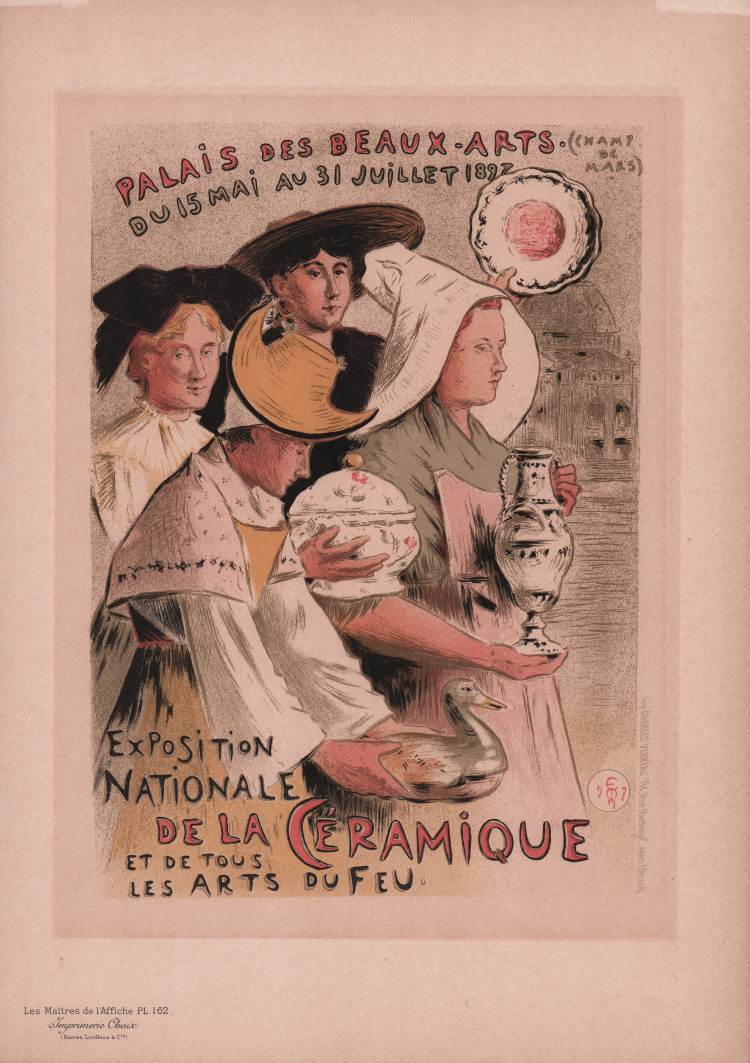



| Reference: | S1675 |
| Author | Étienne-Philippe-Auguste Moreau-Nélaton |
| Year: | 1900 |
| Measures: | 230 x 310 mm |


| Reference: | S1675 |
| Author | Étienne-Philippe-Auguste Moreau-Nélaton |
| Year: | 1900 |
| Measures: | 230 x 310 mm |
Lithograph printed in color on tissue paper, in very good condition. Plate from the fifth annual volume (1900) of Les Maîtres de l'affiche.
Composition created for the 1897 Exposition nationale de la Céramique et de tous les Arts du feu by Etienne Moreau-Nelaton.
Proof with the embossed stamp of Les Maîtres de l'affiche in the lower right corner (Lugt: L.1777c), signed in the plate, printed at Chaix (Ateliers Chéret) rue Bergère in Paris.
Les Maîtres de l'affiche is a monthly French publication printed in France between December 1895 and November 1900. The idea to create the magazine is of Jules Chéret, at the time artistic director of Chaix, a printing house located in Paris at 20 rue Bergère. Each issue includes four posters reproduced using the technique of chromolithography. Each copy had an embossed stamp of authentication. The sale price was 2.50 francs per issue, while a subscription cost 27 francs. There was also a luxury edition on Japan printed in 100 copies and sold for 80 francs for 12 issues.
In January 1897, a first volume was put on sale that included all the affiches published the previous year; the publication had a preface signed by Roger Marx and had a format created by Jean Engel based on a project by Paul Berthon. Until January 1901, the date of the magazine's closure, a total of five volumes were produced, with 97 artists involved.
The 256 color plates that make up the suite represent a wide-ranging selection of outstanding original posters from the turn of the twentieth century when this popular art form first reached its peak.
Early printed posters were very text-heavy, with relatively few illustrations. After all, they were created to advertise products, and adding an illustration to an advertisement in the mid-1800s was not commonplace. However, during the second half of the nineteenth century, when all types of commercial products were aesthetically upgraded, serious artists began to see the new possibilities in the poster medium. By linking their imagery to modern commerce, the thinking was that each would be enhanced by the value of the other. This was especially true for Jules Cheret (1836-1932) whose unique combination of artistic, technical, and entrepreneurial talents paved the way for an actual poster industry. Cheret opened his own print shop in Paris in 1866 – Imprimerie Chaix – and his work then began to inspire numerous emulators throughout Europe and America.
By the 1890s the streets of every great city were enlivened by large, colorful posters. The posters had not only caught the fancy of the public, but its best examples were already being regarded as true works of art (specifically, as fine prints) to be exhibited, reviewed in journals, and collected and reproduced in a more manageable form. In the last five years of the century, the ebullient spirit of the “Belle Epoque,” gave birth to a new artistic movement. It was during those years that Imprimerie Chaix was to play a significant part in codifying, hallowing, and perpetuating Cheret’s vision through printmaking.
Étienne-Philippe-Auguste Moreau-Nélaton (Parigi 1859 – 1927)
|
Adolphe Étienne Auguste Moreau-Nélaton was a French painter, art collector and art historian. His large collection is today held in its entirety by French national museums. Moreau-Nélaton was born and died in Paris. His family's art collecting began with his grandfather Adolphe Moreau (1800–1859). As a stockbroker he possessed ample capital with which to buy the work of artists with whom he was personally acquainted, including Eugène Delacroix and Alexandre-Gabriel Decamps. Moreau-Nélaton's father, who was also named Adolphe Moreau (1827–1882), was a high government official and led the railroad company Chemins de fer de l'Est. In 1856 he married the ceramic artist Camille Nélaton (1840–1897), with whom he further expanded the family's collection. After an 1882 visit to the École Normale Supérieure, Moreau-Nélaton decided to become a painter. He began his artistic education by studying with the artists Henri-Joseph Harpignies and Albert Maignan, who were friends of the family. In 1885 he exhibited for the first time in the Salon de Paris. His painting style was influenced by Édouard Manet and Berthe Morisot. Domestic family scenes were his primary subject matter, but he also painted several landscapes. Some of his works are now in the collection of the Musée d'Orsay.
|
Étienne-Philippe-Auguste Moreau-Nélaton (Parigi 1859 – 1927)
|
Adolphe Étienne Auguste Moreau-Nélaton was a French painter, art collector and art historian. His large collection is today held in its entirety by French national museums. Moreau-Nélaton was born and died in Paris. His family's art collecting began with his grandfather Adolphe Moreau (1800–1859). As a stockbroker he possessed ample capital with which to buy the work of artists with whom he was personally acquainted, including Eugène Delacroix and Alexandre-Gabriel Decamps. Moreau-Nélaton's father, who was also named Adolphe Moreau (1827–1882), was a high government official and led the railroad company Chemins de fer de l'Est. In 1856 he married the ceramic artist Camille Nélaton (1840–1897), with whom he further expanded the family's collection. After an 1882 visit to the École Normale Supérieure, Moreau-Nélaton decided to become a painter. He began his artistic education by studying with the artists Henri-Joseph Harpignies and Albert Maignan, who were friends of the family. In 1885 he exhibited for the first time in the Salon de Paris. His painting style was influenced by Édouard Manet and Berthe Morisot. Domestic family scenes were his primary subject matter, but he also painted several landscapes. Some of his works are now in the collection of the Musée d'Orsay.
|